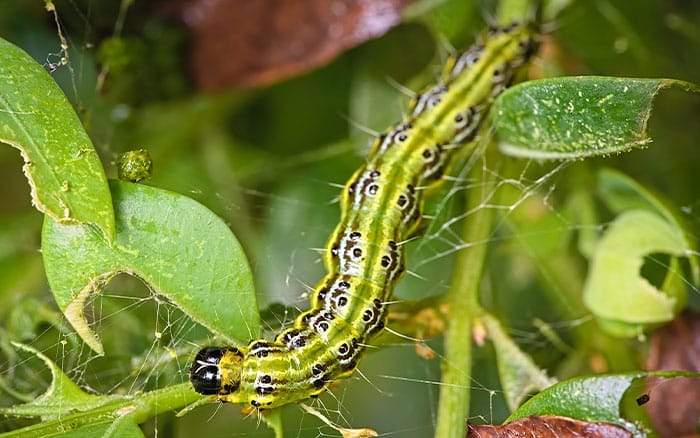Box moth caterpillars can destroy box hedges within a matter of days. Find out everything you need to know about this garden pest, from how to identify to how to treat.
What is Box Moth Caterpillar
This little creature was first identified in UK gardens in 2011, and have become an increasing problem in England amongst growers of Buxus sempervirens (Common box).
These tiny caterpillars, Cydalima perspectalis, can remove box hedges of all of their leaves within just a few days. This is in particularly large infestations.
These larvae are native to East Asia and are thought to have been established in Europe by 2007.
How to spot Box Moth Caterpillar
There are several ways to identify a box caterpillar infestation. The two most common are noticing defoliation of the plant, with leaves damaged or gone completely. The caterpillars eat these leaves, hence why they disappear and don’t fall.
Another way to identify them is a fine webbing all over the box hedge, or in small areas. This is something that box caterpillars naturally produce over their feeding areas.
The caterpillars themselves are a yellow-green colour, with black detail all along, and have black heads. They tend to be no longer than 4 cm in length.



How to control Box Moth Caterpillar
There are a few ways you can try to contain and control a box caterpillar infestation.
As much as possible, you should try to remove the caterpillars by hand. This, depending on how many box hedges you have, is possible in smaller infestations. All you would need to do is have a thorough check of your hedges. The best way to identify where the caterpillars are is to look out for the distinctive webbing. Then, remove them from your Buxus plants.
Another way is to add some nematodes to the soil, which is a safe biological method of control. These are microscopic worms which will seek out the caterpillars, feed on them, and release bacteria inside. Nematodes can be missed with water and then watered onto affected plants and the plants’ soil.
If box caterpillars are too large a problem for these control methods to manage, then perhaps find an alternative to Buxus sempervirens.


Need advice
If you need specialist advice, I would always recommend you speak to your local garden centre, plant nursery or contact the advisory service of the Royal Horticultural Society. Each of these organisations has expert knowledge that can make pest control so much easier. And when speaking to a garden centre or nursery that is local to you, the chances are they will know whether there has been an influx in pests too.

Leave A Comment